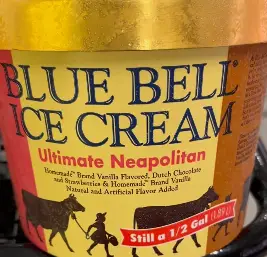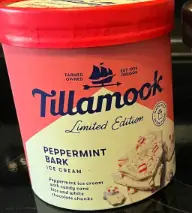I’m an ice cream enthusiast who’s spent countless summer evenings savoring scoops of creamy goodness, and I’ve got a confession: choosing between Tillamook and Blue Bell is no easy feat. Both brands have carved out loyal followings with their rich flavors and storied histories. In this article, I’ll compare Tillamook and Blue Bell, weighing their pros and cons, key features, and what makes each unique. My goal is to help you decide which ice cream deserves a spot in your freezer by analyzing their taste, quality, and more from a real user’s perspective. Let’s scoop in!
Comparison Table: Tillamook Vs. Blue Bell
| Feature | Tillamook | Blue Bell |
| Origin | Tillamook, Oregon | Brenham, Texas |
| Founded | 1909 | 1907 |
| Key Ingredients | High-quality milk, no artificial flavors | High-quality milk, some artificial flavors |
| Texture | Creamy, dense | Light, airy |
| Flavor Variety | 30+ flavors | 40+ flavors |
| Availability | Nationwide, limited international | Primarily Southern U.S., expanding |
| Price (per pint) | $5–$7 | $4–$6 |
| Unique Selling Point | Farmer-owned, premium ingredients | Southern heritage, nostalgic appeal |
My Journey With Ice Cream: Why This Comparison Matters
Read More: My Thought on Carvel Vs. Dairy Queen
As someone who’s been chasing the perfect scoop since childhood, I’ve tasted my fair share of ice creams. Growing up, Blue Bell was a staple at family gatherings, its iconic Homemade Vanilla a comforting constant. Later, when I moved to the West Coast, Tillamook’s bold flavors, like Marionberry Pie, caught my attention. Both brands have a special place in my heart, but they cater to different cravings. To help you choose, I’ll break down their histories, ingredients, flavors, and more, sharing my experiences and insights to guide you through this delicious debate.
A Tale Of Two Creameries: The Origins

Let’s start with the roots. Tillamook, hailing from Oregon’s lush dairy country, began in 1909 as a cooperative of farmers determined to craft exceptional dairy products. I visited their creamery once, and the pride in their craft was palpable—cows grazing nearby, fresh milk flowing into vats. Their focus on quality has made them a darling of the Pacific Northwest, with a reputation for premium, no-nonsense ice cream.
Blue Bell, born in 1907 in Brenham, Texas, has a different vibe. It’s the South’s sweetheart, evoking memories of porch swings and summer picnics. When I first tried Blue Bell, it was at a friend’s barbecue, and the nostalgia hit hard. The brand started as a butter company but pivoted to ice cream, leaning into its Southern charm. Both brands are steeped in tradition, but Tillamook feels like a craftsman’s labor of love, while Blue Bell is all about heartwarming familiarity.
Ingredients: What’s Inside The Carton?
When I pop open a pint, I want to know what I’m eating. Tillamook prides itself on using high-quality milk from local cows, free of artificial growth hormones like rBST. Their ingredient lists are short and sweet—no artificial flavors or preservatives. For example, their Chocolate Peanut Butter ice cream lists real peanut butter and cocoa, which I appreciate as someone who values transparency. This purity gives Tillamook a rich, clean taste that feels indulgent yet wholesome.
Blue Bell, on the other hand, uses high-quality milk too, but some flavors include artificial flavors or stabilizers like guar gum. Their Cookies ’n Cream, a personal favorite, has a slightly processed edge compared to Tillamook’s offerings. However, Blue Bell’s ingredients still meet high standards, and their milk is sourced from regional farms. If you’re a purist, Tillamook’s simplicity might win you over, but Blue Bell’s approach doesn’t skimp on quality—it just leans into accessibility.
Texture and Creaminess: The Mouthfeel Test
Texture is where these two brands diverge. Tillamook’s ice cream is dense and velvety, almost like a frozen custard. When I scoop their Vanilla Bean, it’s thick, coating the spoon like a dream. This comes from their high butterfat content (around 14–16%) and minimal air churned into the mix, a process called low overrun. It’s perfect for slow, savoring bites.
Blue Bell, by contrast, is lighter and airier, with a higher overrun that makes it fluffier. Their Homemade Vanilla feels like a cloud melting on your tongue, which I love for quick, refreshing scoops on a hot day. However, this airiness can make some flavors feel less substantial. If you crave decadence, Tillamook’s density is unbeatable; if you want something lighter, Blue Bell’s your pick.
Flavor Showdown: Variety and Innovation
Flavor is where the fun begins. Tillamook offers over 30 flavors, from classics like Chocolate to inventive ones like Waffle Cone Swirl. Their Marionberry Pie, with its tart berry chunks and pie crust swirls, is a standout—it’s like a dessert within a dessert. I admire how Tillamook balances bold and subtle, with natural ingredients shining through. Their limited-edition flavors, like Peach Cobbler, keep things exciting, though they’re not always easy to find.
Blue Bell boasts over 40 flavors, with a knack for Southern-inspired options. Their Butter Crunch, with its toffee-like richness, is a crowd-pleaser at my family gatherings. They also rotate seasonal flavors like Peppermint Bark, which adds variety but can frustrate fans when favorites disappear. Blue Bell’s flavors lean nostalgic, evoking childhood memories, while Tillamook feels more artisanal. If you love variety, Blue Bell’s edge in sheer numbers might sway you; if you prioritize unique, premium profiles, Tillamook takes the lead.
Availability: Can You Get It?

One of my biggest gripes as an ice cream lover is when I can’t find my favorite brand. Tillamook has expanded nationwide, available in most major grocery stores like Safeway or Whole Foods. Their pints and family-sized cartons are easy to spot, though some specialty flavors are region-specific. Internationally, they’re harder to come by, which disappointed me during a trip abroad.
Blue Bell, historically a Southern brand, is trickier. It’s widely available in states like Texas, Alabama, and Georgia, but northern and western U.S. markets often miss out. They’re expanding, but if you’re outside the South, you might need to hunt. This limited reach is a bummer for Blue Bell fans like me who’ve moved away from their strongholds. Tillamook’s broader distribution gives it an edge here.
Price Point: Is It Worth Your Dollar?
Read More: My Thought on Carvel Vs. Dairy Queen
Let’s talk money. Tillamook’s pints typically cost $5–$7, reflecting their premium positioning. At my local store, a pint of their Mudslide is about $6.50, which feels steep but justified by the quality. Their family-sized cartons offer better value for bulk buyers.
Blue Bell’s pints are slightly cheaper, ranging from $4–$6. I’ve snagged their Southern Blackberry Cobbler for $5 at a Texas grocery store, a steal for the flavor. However, their smaller pint sizes (16 oz vs. Tillamook’s 18 oz) can make the value feel less impressive. If budget’s a concern, Blue Bell’s lower price is appealing, but Tillamook’s quality justifies the splurge.
Pros And Cons: Breaking It Down
Tillamook Pros
- Premium Ingredients: No artificial flavors or preservatives, using high-quality milk from rBST-free cows.
- Rich Texture: Dense, creamy mouthfeel that feels indulgent and satisfying.
- Nationwide Availability: Easy to find in most U.S. grocery stores.
- Unique Flavors: Artisanal options like Marionberry Pie stand out.
- Farmer-Owned: The cooperative model adds a feel-good factor.
Tillamook Cons
- Higher Price: Pints are pricier, which might deter budget-conscious buyers.
- Limited International Reach: Hard to find outside the U.S.
- Fewer Flavors: Less variety compared to Blue Bell’s extensive lineup.
Blue Bell Pros
- Nostalgic Appeal: Southern heritage and classic flavors resonate emotionally.
- Affordable: Generally cheaper than Tillamook, offering good value.
- Flavor Variety: Over 40 flavors, including seasonal and regional options.
- Light Texture: Airy mouthfeel is refreshing and approachable.
Blue Bell Cons
- Limited Availability: Primarily Southern U.S., tough to find elsewhere.
- Artificial Ingredients: Some flavors use artificial flavors or stabilizers.
- Less Dense: Airier texture may feel less premium to some.
Sustainability And Ethics: Do They Care?
As someone who cares about where my food comes from, I looked into both brands’ practices. Tillamook’s farmer-owned cooperative model is a big plus. Their cows are raised without rBST, and they emphasize sustainable farming practices, like reducing water usage. Visiting their creamery, I saw their commitment to local farmers firsthand, which makes me feel good about supporting them.
Blue Bell doesn’t highlight sustainability as much, but they source milk from regional farms and maintain high safety standards. After a 2015 listeria recall, they revamped their processes, showing accountability. However, their lack of transparency about environmental practices is a drawback compared to Tillamook’s openness. If ethics matter to you, Tillamook has a slight edge.
Packaging And Presentation: The Visual Appeal

Packaging might seem trivial, but it sets the mood. Tillamook’s pints have a clean, modern look with earthy tones and clear flavor descriptions. Their cartons feel sturdy, and the branding screams “premium.” When I grab a pint, it feels like a treat.
Blue Bell’s packaging leans nostalgic, with a vintage logo and playful fonts. Their gold-rimmed cartons evoke old-school ice cream parlors, which I find charming. However, their pints sometimes feel flimsier, and the design can look dated. Tillamook wins for aesthetics, but Blue Bell’s retro vibe has heart.
My Taste Tests: A Personal Take
To settle this debate, I conducted my own taste tests. For Tillamook, I tried their Chocolate Peanut Butter and Marionberry Pie. The Chocolate Peanut Butter was a revelation—silky chocolate with ribbons of real peanut butter that didn’t overpower. The Marionberry Pie felt like a homemade dessert, with tart berries and buttery crust bits.
For Blue Bell, I went with Homemade Vanilla and Butter Crunch. The vanilla was smooth and nostalgic, perfect for pairing with pie. Butter Crunch had a toffee-like depth, but the texture was lighter than I’d hoped. Tillamook’s density won me over, but Blue Bell’s flavors hit my nostalgia button hard.
Which Brand Suits You?
Your choice depends on what you value. If you’re after premium quality, rich texture, and sustainable practices, Tillamook’s your go-to. Its nationwide availability makes it a practical choice, though the price might sting. If you love variety, affordability, and Southern charm, Blue Bell’s a winner—provided you can find it. For me, Tillamook edges out slightly for its craftsmanship, but Blue Bell’s nostalgic pull keeps it close.
Frequently Asked Questions
Yes, Blue Bell uses high-quality milk and regional ingredients, offering a nostalgic, flavorful experience, though some flavors include artificial additives.
Absolutely, Tillamook is considered premium due to its rBST-free milk, natural ingredients, and dense, artisanal texture.
Blue Bell competes with brands like Tillamook, Ben & Jerry’s, Häagen-Dazs, and regional players like Breyers.
Based on quality, popularity, and innovation, I’d rank Ben & Jerry’s, Tillamook, and Häagen-Dazs as the top three, with Blue Bell close behind.
Conclusion: Your Scoop, Your Choice
Read More: My Thought on Carvel Vs. Dairy Queen
You’ve got two fantastic ice cream brands vying for your freezer space. Tillamook’s premium ingredients and rich texture make it a go-to for indulgence, while Blue Bell’s nostalgic flavors and affordability bring Southern charm to every bite. Whether you’re craving a decadent treat or a taste of childhood, both deliver. Grab a pint of each, do your own taste test, and let your taste buds decide. I’ve shared my journey—now it’s your turn to scoop up the fun and find your favorite!
